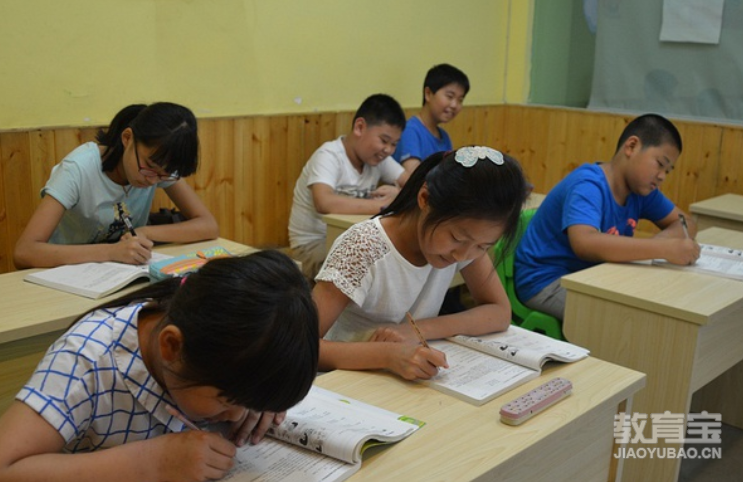 返回
教育头条
返回
教育头条

托福阅读原文及题目分享
在备考的过程中,考生一般都会拿TPO来进行托福考试的练习。因为其涵盖了大量托福考试的题型,能够帮助考生快速了解各类题型,从而更有针对性攻克自己的短板。今天小编为大家整理了托福阅读Geothermal Energy原文及题目,一起来了解一下吧!
Geothermal Energy
Earth’s internal heat, fueled by radioactivity, provides the energy for plate tectonics and continental drift, mountain building, and earthquakes. It can also be becomes available in a practical form when underground heat is transferred by water that is heated as it passes through a subsurface region of hot rocks (a heat reservoir) that may be hundreds or thousands of feet deep. The water is usually naturally occurring groundwater that seeps down along fractures in the rock; less typically, the water is artificially introduced by being pumped down from the surface. The water is brought to the surface, as a liquid or steam, through holes drilled for the purpose.
By far the most abundant form of geothermal energy occurs at the relatively low temperatures of 80°to 180°centigrade. Water circulated through heat reservoirs in this temperature range is able to extract enough heat to warm residential, commercial, and industrial spaces. More than 20,000 apartments in France are now heated by warm underground water drawn from a heat reservoir in a geologic structure near Paris called the Paris Basin. Iceland sits on a volcanic structure known as the Mid-Atlantic Ridge. Reykjavik, the capital of Iceland, is entirely heated by geothermal energy derived from volcanic heat.
Geothermal reservoirs with temperatures above 180°centigrade are useful for generating electricity. They occur primarily in regions of recent volcanic activity as hot, dry rock; natural hot water; or natural steam. The latter two sources are limited to those few areas where surface water seeps down through underground faults or fractures to reach deep rocks heated by the recent activity of molten rock material. The world’s largest supply of natural steam occurs at the Geysers, 120 kilometers north of san Francisco, California. In the 1990s enough electricity to meet about half the needs of San Francisco was being generated there. This facility was then in its third decade of production and was beginning to show signs of decline, perhaps because of over development. By the late 1990s some 70 geothermal electric-generating plants were in operation in California, Utah, Nevada, and Hawaii, generating enough power to supply about a million people. Eighteen countries now generate electricity using geothermal heat.
Extracting heat from very hot, dry rocks present a more difficult problem: the rocks must be fractured to permit the circulation of water, and the water must be provided artificially. The rocks are fractured by water pumped down at very high pressures. Experiments are under way to develop technologies for exploiting this resource.
Like most other energy sources, geothermal energy presents some environmental problems. The surface of the ground can sink if hot groundwater is withdrawn without being replaced. In addition, water heated geothermally can contain salts and toxic materials dissolved from the hot rock. These waters present a disposal problem if they are not returned to the ground from which they were removed.
The contribution of geothermal energy to the world’s energy future is difficult to estimate. Geothermal energy is in a sense not renewable, because in most cases the heat would be drawn out of a reservoir much more rapidly than it would be replaced by the very slow geological processes by which heat flows through solid rock into a heat reservoir. However, in many places (for example, California, Hawaii, the Philippines, Japan ,Mexico, the rift valleys of Africa) the resource is potentially so large that its future will depend on the economics of production. At present, we can make efficient use of only naturally occurring hot water or steam deposits . Although the potential is enormous, it is likely that in the near future geothermal energy can make important local contributions only where the resource is close to the user and the economics are favorable, as they are in California, New Zealand, and Iceland. Geothermal energy probably will not make large-scale contributions to the world energy budget until well into the twenty-first century, if ever.
考试科目:
Q1 According to the processes described in paragraph 1, what is the relationship between radioactivity and the steam produced by geothermal heat?
A. Geothermally heated steam is produced when water is exposed to radioactivity deep underground. B. When water is introduced into holes drilled thousands of feet in the ground, it becomes radioactive and turns to steam. C. Radioactivity heats Earth‘s interior rock, which in turn can heat water to the point becomes steam. D. When a reservoir of steam in subsurface rock is produced by radioactivity, it is said to be geothermally heated.
Q2 The word ―practical ‖in the passage is closest in meaning to
A. usable B. plentiful C. economical D. familiar
Q3 The word ―abundant‖ in the passage is closest in meaning to
A. economical B. familiar C. plentiful D. useful
Q4 According to paragraph 2, which of the following is true about heat reservoirs with a temperature in the range of 80°to 180°centigrade?
A. They are under international control. B. They are more common than reservoirs that have a higher temperature. C. Few of them produce enough heat to warm large industrial spaces. D. They are used to generate electricity.
Q5 According to paragraph 3, what is the connection between underground faults and naturally occurring steam?
A. faults enable the heat from molten-rock material to escape upward to regions where it can heat surface water enough to produce steam. B. faults are created by steam that is produced in geothermal reservoirs deep inside Earth. C. faults create spaces in which natural steam is sometimes trapped. D. faults allow surface water to reach deep rocks that are hot enough to turn it into steam.
Q6 In paragraph 3, why does the author mention that in the 1990s the Geysers were in its third decade of production?
A. To provide the historical context of the geothermal production of electricity in the United States B. To imply that the Geysers was the first geothermal site to be put into production in California C. To help explain the signs of decline shown by the Geysers D. To explain why 70 new geothermal sites were put into electricity production in the late 1990s
Q7 Which of the following can be inferred from paragraphs 2 and 3 about geothermal reservoirs?
A. Volcanic heat is associated only with geothermal reservoirs that have a temperature over 180°centigrade. B. More countries produce power from geothermal reservoirs than use them for heating buildings. C. Most geothermal reservoirs are suitable fro producing electricity. D. A higher geothermal reservoir temperature is needed to generate electricity than is needed to heat homes.

Q8 According to paragraph 4, extracting heat from very hot, dry rocks is difficult in part because
A. The underground rock must be fractured before heat can be removed from it. B. The water above the rock is under very high pressure C. The rock breaks apart when water is pumped into it D. The water circulated through the rock must be much cooler than the rock itself
Q9 The word ―exploiting‖ in the passage is closest in meaning to
A locating B increasing C making use of D estimating the size of
Q10 How is the problem that the surface man sink related to the problem that water heated geothermally may contain toxic materials?
A. Both problems could be solved by returning groundwater that is removed from an underground heat reservoir back to the reservoir after heat is extracted from it . B. The problem of sinking is more difficult to solve than is the problem of toxic materials. C. Land at the surface sinks because the rock beneath the surface is weakened when salts and toxic materials are removed from it in the process of extracting geothermal energy. D. Both problems are caused by the fact that the hot groundwater in a heat reservoir dissolves the rock, which weakens the rock and makes the water toxic with salt.
Q11 Which of the sentences below best expresses the essential information in the highlighted sentence in the passage? Incorrect choices change the meaning in important ways or leave out essential information.
A. Heat flows through solid rock very slowly, so it takes a very long time for geological processes to produce a reservoir of geothermal energy. B. Geothermal energy is not renewable because heat flows very slowly through solid rock into of our of a heat reservoir. C. The heat quickly removed from a heat reservoir is replaced so slowly by geological processes that geothermal energy is not, practically speaking, renewable. D. In most cases, heat travels into a heat reservoir so slowly that it is a much quicker process to remove the heat from a reservoir than to replace it.
Q12 In paragraph 6, the author implies that in California, Hawaii, the Philippines, Japan, Mexico, and the rift valleys of Africa the potential size of the geothermal resource is so large that
A. It might be economically worth developing these sites even though geothermal energy is not renewable B. These sites will be the first geothermal energy sites to be developed with new technology. C. These sites are likely to make a large-scale contribution to the world energy budget in the twenty-first century D. It does not matter whether they have naturally occurring deposits of hot water or steam.
Geothermal Energy
Earth’s internal heat, fueled by radioactivity, provides the energy for plate tectonics and continental drift, mountain building, and earthquakes. It can also be becomes available in a practical form when underground heat is transferred by water that is heated as it passes through a subsurface region of hot rocks (a heat reservoir) that may be hundreds or thousands of feet deep. The water is usually naturally occurring groundwater that seeps down along fractures in the rock; less typically, the water is artificially introduced by being pumped down from the surface. The water is brought to the surface, as a liquid or steam, through holes drilled for the purpose.
By far the most abundant form of geothermal energy occurs at the relatively low temperatures of 80°to 180°centigrade. Water circulated through heat reservoirs in this temperature range is able to extract enough heat to warm residential, commercial, and industrial spaces. More than 20,000 apartments in France are now heated by warm underground water drawn from a heat reservoir in a geologic structure near Paris called the Paris Basin. Iceland sits on a volcanic structure known as the Mid-Atlantic Ridge. Reykjavik, the capital of Iceland, is entirely heated by geothermal energy derived from volcanic heat.
Geothermal reservoirs with temperatures above 180°centigrade are useful for generating electricity. They occur primarily in regions of recent volcanic activity as hot, dry rock; natural hot water; or natural steam. The latter two sources are limited to those few areas where surface water seeps down through underground faults or fractures to reach deep rocks heated by the recent activity of molten rock material. The world’s largest supply of natural steam occurs at the Geysers, 120 kilometers north of san Francisco, California. In the 1990s enough electricity to meet about half the needs of San Francisco was being generated there. This facility was then in its third decade of production and was beginning to show signs of decline, perhaps because of over development. By the late 1990s some 70 geothermal electric-generating plants were in operation in California, Utah, Nevada, and Hawaii, generating enough power to supply about a million people. Eighteen countries now generate electricity using geothermal heat.
Extracting heat from very hot, dry rocks present a more difficult problem: the rocks must be fractured to permit the circulation of water, and the water must be provided artificially. The rocks are fractured by water pumped down at very high pressures. Experiments are under way to develop technologies for exploiting this resource.
Like most other energy sources, geothermal energy presents some environmental problems. The surface of the ground can sink if hot groundwater is withdrawn without being replaced. In addition, water heated geothermally can contain salts and toxic materials dissolved from the hot rock. These waters present a disposal problem if they are not returned to the ground from which they were removed.
The contribution of geothermal energy to the world’s energy future is difficult to estimate. Geothermal energy is in a sense not renewable, because in most cases the heat would be drawn out of a reservoir much more rapidly than it would be replaced by the very slow geological processes by which heat flows through solid rock into a heat reservoir. However, in many places (for example, California, Hawaii, the Philippines, Japan ,Mexico, the rift valleys of Africa) the resource is potentially so large that its future will depend on the economics of production. At present, we can make efficient use of only naturally occurring hot water or steam deposits . Although the potential is enormous, it is likely that in the near future geothermal energy can make important local contributions only where the resource is close to the user and the economics are favorable, as they are in California, New Zealand, and Iceland. Geothermal energy probably will not make large-scale contributions to the world energy budget until well into the twenty-first century, if ever.
考试科目:
Q1 According to the processes described in paragraph 1, what is the relationship between radioactivity and the steam produced by geothermal heat?
A. Geothermally heated steam is produced when water is exposed to radioactivity deep underground. B. When water is introduced into holes drilled thousands of feet in the ground, it becomes radioactive and turns to steam. C. Radioactivity heats Earth‘s interior rock, which in turn can heat water to the point becomes steam. D. When a reservoir of steam in subsurface rock is produced by radioactivity, it is said to be geothermally heated.
Q2 The word ―practical ‖in the passage is closest in meaning to
A. usable B. plentiful C. economical D. familiar
Q3 The word ―abundant‖ in the passage is closest in meaning to
A. economical B. familiar C. plentiful D. useful
Q4 According to paragraph 2, which of the following is true about heat reservoirs with a temperature in the range of 80°to 180°centigrade?
A. They are under international control. B. They are more common than reservoirs that have a higher temperature. C. Few of them produce enough heat to warm large industrial spaces. D. They are used to generate electricity.
Q5 According to paragraph 3, what is the connection between underground faults and naturally occurring steam?
A. faults enable the heat from molten-rock material to escape upward to regions where it can heat surface water enough to produce steam. B. faults are created by steam that is produced in geothermal reservoirs deep inside Earth. C. faults create spaces in which natural steam is sometimes trapped. D. faults allow surface water to reach deep rocks that are hot enough to turn it into steam.
Q6 In paragraph 3, why does the author mention that in the 1990s the Geysers were in its third decade of production?
A. To provide the historical context of the geothermal production of electricity in the United States B. To imply that the Geysers was the first geothermal site to be put into production in California C. To help explain the signs of decline shown by the Geysers D. To explain why 70 new geothermal sites were put into electricity production in the late 1990s
Q7 Which of the following can be inferred from paragraphs 2 and 3 about geothermal reservoirs?
A. Volcanic heat is associated only with geothermal reservoirs that have a temperature over 180°centigrade. B. More countries produce power from geothermal reservoirs than use them for heating buildings. C. Most geothermal reservoirs are suitable fro producing electricity. D. A higher geothermal reservoir temperature is needed to generate electricity than is needed to heat homes.

Q8 According to paragraph 4, extracting heat from very hot, dry rocks is difficult in part because
A. The underground rock must be fractured before heat can be removed from it. B. The water above the rock is under very high pressure C. The rock breaks apart when water is pumped into it D. The water circulated through the rock must be much cooler than the rock itself
Q9 The word ―exploiting‖ in the passage is closest in meaning to
A locating B increasing C making use of D estimating the size of
Q10 How is the problem that the surface man sink related to the problem that water heated geothermally may contain toxic materials?
A. Both problems could be solved by returning groundwater that is removed from an underground heat reservoir back to the reservoir after heat is extracted from it . B. The problem of sinking is more difficult to solve than is the problem of toxic materials. C. Land at the surface sinks because the rock beneath the surface is weakened when salts and toxic materials are removed from it in the process of extracting geothermal energy. D. Both problems are caused by the fact that the hot groundwater in a heat reservoir dissolves the rock, which weakens the rock and makes the water toxic with salt.
Q11 Which of the sentences below best expresses the essential information in the highlighted sentence in the passage? Incorrect choices change the meaning in important ways or leave out essential information.
A. Heat flows through solid rock very slowly, so it takes a very long time for geological processes to produce a reservoir of geothermal energy. B. Geothermal energy is not renewable because heat flows very slowly through solid rock into of our of a heat reservoir. C. The heat quickly removed from a heat reservoir is replaced so slowly by geological processes that geothermal energy is not, practically speaking, renewable. D. In most cases, heat travels into a heat reservoir so slowly that it is a much quicker process to remove the heat from a reservoir than to replace it.
Q12 In paragraph 6, the author implies that in California, Hawaii, the Philippines, Japan, Mexico, and the rift valleys of Africa the potential size of the geothermal resource is so large that
A. It might be economically worth developing these sites even though geothermal energy is not renewable B. These sites will be the first geothermal energy sites to be developed with new technology. C. These sites are likely to make a large-scale contribution to the world energy budget in the twenty-first century D. It does not matter whether they have naturally occurring deposits of hot water or steam.
以上就是教育宝头条带来的托福阅读原文及题目分享详细介绍,想要查看更多托福资讯,敬请关注教育宝头条,也可以加我微信18560125702,我会解答你的学习问题。返回教育宝头条
【免责声明】本文仅代表作者本人观点,与教育宝无关。教育宝对文中陈述、观点判断保持中立,不对所包含内容的准确性、可靠性或完整性提供任何保证。请读者仅作参考,特此声明!





